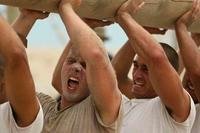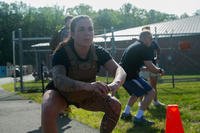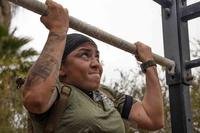Almost every day, people young and old confide in me with their fitness goals. Too many of these goals are extremely broad and lack focus, and many others are too narrow in scope and require additional elements to succeed.
For example, broad goals might be "getting healthy again" or "losing weight." These goals may require someone to stop smoking, drinking soda or overeating, and they also will have to start exercising. But if someone tries to do all of the above in the same week, they statistically are destined to fail.
The opposite problem occurs when someone "wants to do pull-ups." Depending on their current fitness level, this could require that person to start using weights to strengthen their grip, biceps and back muscles as well as lose weight. Too many people cannot do pull-ups mainly because they carry an extra 20-25 pounds.
The common denominator between men and women who can perform pull-ups is that "they practice pull-ups 2-3 times a week as part of their weekly workout routine." See pull-up articles in the Stew Smith article archive.
There is a standard method of achieving your fitness and health goals. Quite simply, it requires baby steps if you are a beginner and a foundation of several elements if you are currently active and seeking more advanced goals.
These elements are the following:
Moving = Exercise
If you add exercise to your world, this will be a shock to the system until you build a habit and create that foundation of fitness I discussed earlier. This can be as simple as walking or biking for 10-15 minutes every day or an hourlong workout in the gym with a combination of weights and cardio equipment.
To do more pull-ups or push-ups or to run faster, you already have to be very active; otherwise you need to create the foundation on which to build these follow-on goals. This is why military members who only exercise 1-2 weeks before their biannual fitness test continually score worse than the year before. To beat last year's scores, you need to make fitness part of your schedule.
Eating
Eating to lose weight or eating a healthy diet with balanced nutrition is a lifestyle that should be adopted over time. When you add exercise to your schedule 4-5 times a week, it is important to increase your water consumption to 2-4 quarts a day. Just add exercise and drink more water the first month of your exercise schedule.
If you see weight loss within the first week or two, you may not need to alter your food intake that much. Your body also will start to drive you toward eating more fruits, vegetables and protein sources if you have a steady exercise program, too. But for more ideas on what to eat, see the following links:
Flexibility
Stretching is highly important to increasing scores on fitness tests, as well as for overall conditioning. Prevention of injuries through a steady flexibility routine before and after each fitness session will enable you to continue exercise and not have to stop your program because of pulled muscles or stiff joints. See the "Stretching Plan" article that I recommend that beginners do for a solid week prior to starting a fitness schedule.
Schedule
The final element of successful goal achievement is integrating fitness into your schedule. "If it is not in the schedule, it does not exist." An early morning workout is three times easier to accomplish, compared to a post-work fitness session. Everyday conflicts that delay or cancel your afternoon workout always can arise. But as the days get longer during these spring and summer months, making that after-work workout is a bit easier.
So hang in there with your goals and keep chugging away; soon, the days become weeks and the weeks become months. After a few months of exercising, eating properly, drinking more water and stretching, you can be faster, stronger and lose up to 20 pounds.
Stew Smith is a former Navy SEAL and fitness author certified as a Strength and Conditioning Specialist (CSCS) with the National Strength and Conditioning Association. Visit his Fitness eBook store if you're looking to start a workout program to create a healthy lifestyle. Send your fitness questions to stew@stewsmith.com.
Want to Learn More About Military Life?
Whether you're thinking of joining the military, looking for fitness and basic training tips, or keeping up with military life and benefits, Military.com has you covered. Subscribe to Military.com to have military news, updates and resources delivered directly to your inbox.




















